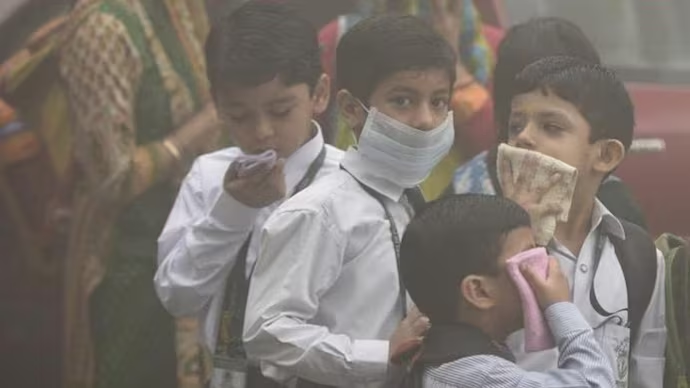Pratiba Sopori, Principal of Noida Public School, shares insights into her remarkable journey in education, marked by a passion for transformation and unwavering commitment to student well-being in this interview with Education Post's Prabhav Anand. From revitalizing school environments to fostering a culture of empathy and inclusion, Sopori's leadership exemplifies the power of education to shape lives.
Q. Could you share a personal experience or anecdote that has shaped your dedication to education and leadership within the school community?

Backed up with the best teachers I had in school, took several initiatives to redecorate the school, make it clean, well-lit, safe and above all fun to be in. The quick wins were astonishing.
I believe that school principals should neither avoid handling school challenges nor be afraid to address anything that may harm students. I came up with this slogan “So what? Now what?” to reflect my belief that the current situation can be worked on instead of blaming circumstances.
I knew immediately that the teachers needed assistance as they knew what to teach but not how to teach it. I, with their support, developed a lesson-delivery model for instruction helping individual students to learn in small groups efficiently.
The best way was to talk directly about the importance of loving your students and to drive their emotion.
I proved my devotion and compassion by doing things that were traditionally considered out of the school Principal’s responsibility like managing the special and value-based assemblies counseling sessions, talking to students and showing affection to them. She made each and every one of them feel special by holding individual birthdays as a way of showing empathy for each student. Unlike some principals, I interacted daily with students, listening to their complaints and problems and tackling all the challenges with undivided attention. As a result, average test scores went up, more students from the other schools got accepted.
I always believe that an educational leader should always provide children with hope, and had a great effect on my school by using love and care as an approach.
As a teacher I dedicated 17 years of my life to the noble profession of teaching. At school, I always assumed the role of a second guardian to my students, monitoring their holistic graph.
There are benefits to being a public school teacher and school leader, but it also involves its fair share of hardships. Like other school professionals, I also faced many challenges of handling a large class, working longer hours, and lack of resources. Fortunately, my kids are doing well in school and have received scholarships and came out in flying colors in their respective streams
Given the situation and the demands of my job, I bravely and passionately overcame all these daily hurdles with support from my husband, my children and my creative staff by creating visual aids, preparing learning materials, decorating the classroom and innovative curriculum.
The flames of passion ignite and burn.
I believe in the power of holistic learning, encouraging our students to explore their potential academically and personally.
Q. With the implementation of the National Education Policy 2020, what strategies does your institution plan to adopt to align with the policy's objectives and enhance the overall learning experience for students?
While there are many provisions in NEP 2020, the success of the program rests on four main pillars that schools need to embrace and immerse in the coming academic session 2024-25.
Our school redesigned the structural framework into these four levels, with qualified sectional heads/coordinators, each with expertise and depth of knowledge to handle the academic planning, changed TL processes, revised assessments, integrated activities, etc. for that level.
There will be a major reduction in the content in the syllabus for each grade, and there is a proposal to teach in the mother tongue/local language (where possible) to ensure understanding. Teachers are advised to adopt a top-down approach of shifting from syllabus completion to defining learning goals, curating classroom instruction through innovative pedagogy mapped to age-appropriate learning outcomes; knowledge-skills-attitudes; ensuring experiential / project-based learning aligned to real-life situations, thereby shifting from ‘Content & Course completion’ to ‘Competency and Confidence’.
Annual planning should not be adhered to chapters in textbooks; rather they must be aligned to the Minimum Learning Levels syllabus for each Grade. There will be integration of subject streams, aesthetic and performing arts, sports games, and technology to create a holistic learning experience for students, along with the component of digital literacy, scientific temper, and computational thinking, across levels as applicable.
NEP 2020 proposes a major shift in the structure assessments as well as the nature of assessments. It advocates a multi-layered and multi-sourced 360o assessment. We planned the reduction in formal time-bound exams (like the weekly, fortnightly 20/50 marks tests) and an increase in formative assessments, driven by the schema of competency-based assessments mapped to multi-dimensional rubrics of achievement.
Q. In today's digital age, technology has become an integral part of education. How does your school leverage technology to facilitate teaching and learning, and how do you ensure equitable access to digital resources for all students?
Before we can learn about the implementation of technology in school curriculum, it is very important to have a clear definition of digital access. This concept emerges with the commercialization of electronic devices to the public. Since electronic tools are available, digital access is the level of participation of students in the use of digital tools, which include both devices and software programs. Now, let's take a look at the methods that our school applies to ensure that students have equitable digital access to promote responsible use of technology.
Equitable Access to Tools
The equitable access to digital resources involves ensuring that all students have the same opportunity to use and enjoy the benefits of digital access. Within digital access, this is not just about the physical devices that are available (such as computers or tablets) but also the software programs that enable digital activities. Here are some methods that we in school ensure for equitable access to digital tools by students.
Use the Governmental Resources for Digital Access
This year our school makes sure that the school uses the available grants to purchase a new software program that will help students who need to build literacy skills which include- DIKSHA, Vidhya Daan, E-Textbooks, PRAGYATA, Shiksha Vani, Jaduai Pitara, ePathshala, NISHTHA, MOOCs on SWAYAM etc.
Work Along with Teachers
School leaders cannot forget that teachers are the immediate contact between school leadership and students. Any ideas school leaders have to implement access to digital tools for students should work if teachers are part of the process.
The definition of digital access in schools is that it has to do with the level of participation of students in the use of digital tools, which the definition of digital access in schools is that it has to do with the level of participation of students in the use of digital tools, which include both devices and software programs.
The methods that school leaders can apply to ensure students have equitable access to digital tools are:
- Use governmental resources for digital access.
- Work along with teachers in the process of implementing new digital tools.
- Implement digital literacy programs.
- Enable digital access through partnerships.
The methods that school leaders can apply to promote responsible use of digital tools are:
Open conversation on the importance of digital responsibility.
Q. Social issues like bullying, mental health concerns, and student diversity can impact the school environment. How does your school address these challenges to create a supportive and inclusive atmosphere for students?
To address challenges like bullying, discrimination, and isolation, it is essential to raise awareness and promote education. We conduct workshops, seminars, and awareness campaigns that address the importance of inclusivity, empathy, and respect, educate students and staff about the negative impacts of these challenges and emphasize the value of diversity and acceptance.
Implementing awareness programs in schools is vital to address and prevent issues like bullying, discrimination, and isolation. These programs include a range of workshops and seminars throughout the academic year, covering various relevant topics. Some potential workshop and seminar topics include Promoting Respect and Empathy, Understanding and Addressing Bullying, Celebrating Diversity and Inclusion, Building Healthy Relationships, Cyber Safety and Digital Citizenship, and Creating an Inclusive School Culture.
We have included these sessions at key points during the academic year, such as the beginning of the school year, anti-bullying month, cultural appreciation events, and mental health awareness week, to ensure consistent and timely engagement with students, teachers, and staff.
Implement Anti-Bullying Measures
Bullying is a significant barrier to a sense of belonging. At the school level, we must establish robust anti-bullying policies and procedures. We encourage students to confidentially report incidents and take immediate and appropriate action against bullies, provide support mechanisms like counseling services and peer support groups for victims, empower bystanders to intervene safely and create a culture where bullying is not tolerated.
In a line, our students celebrate and embrace diversity within the school community. Encourage student-led initiatives such as diversity clubs or cultural events that promote understanding and appreciation of different backgrounds, incorporate diverse perspectives and experiences into the curriculum to ensure students feel represented and valued. Create inclusive spaces where students can express their identities without fear of discrimination.
Developing positive relationships among students, teachers, and staff is vital for fostering a sense of belonging. Encourage open communication channels where students feel comfortable discussing their concerns and seeking support. Implement mentoring programs that pair older students with younger ones, creating opportunities for guidance and friendship. Teachers should actively engage with students, showing empathy and providing encouragement.

Q. Amid the evolving educational landscape, what innovative programs or initiatives is your institution implementing to promote student engagement and academic excellence?
Student engagement can be developed through innovative teaching methodologies, promote active learning and critical thinking, conduct research to advance knowledge, provide mentorship to students, and participate in professional development activities to stay updated with teaching technologies and practices.
Incorporate group work, projects, and hands-on exercises to keep students engaged and enhance their learning experience. By granting students more autonomy and encouraging them to take ownership of their education, we empower them to become active learners.














